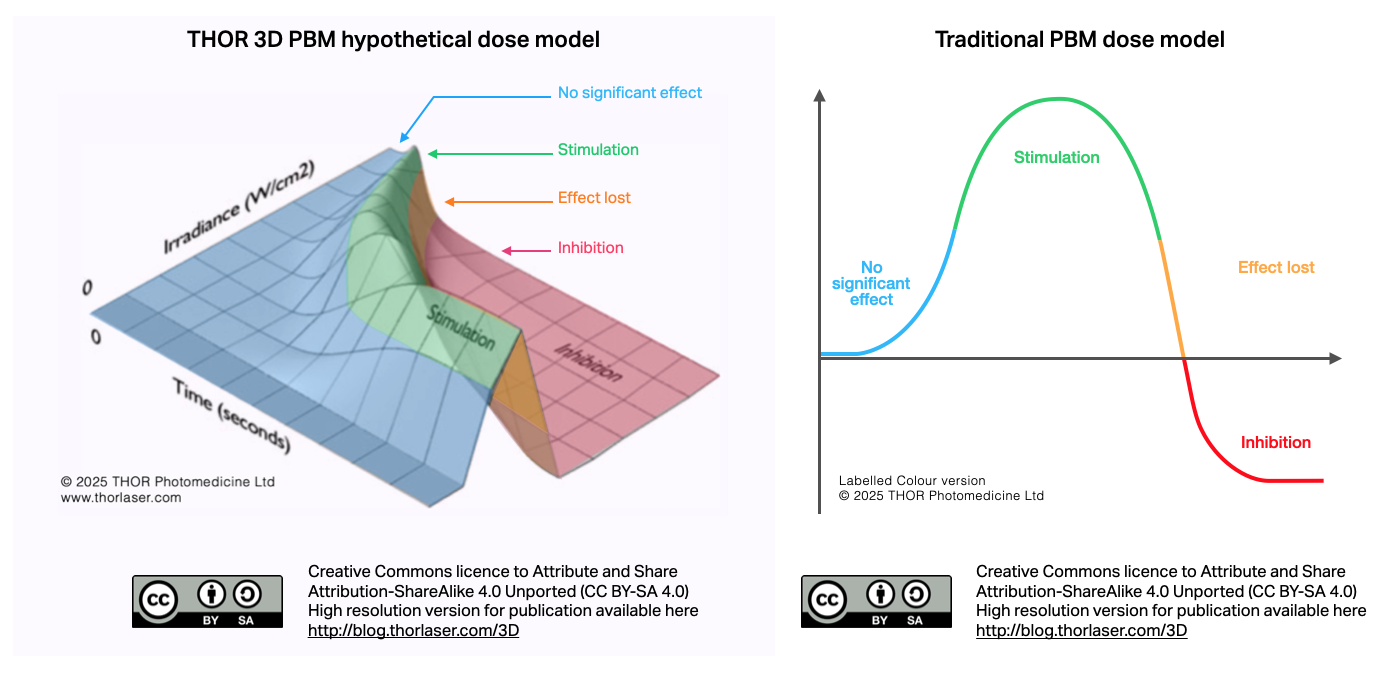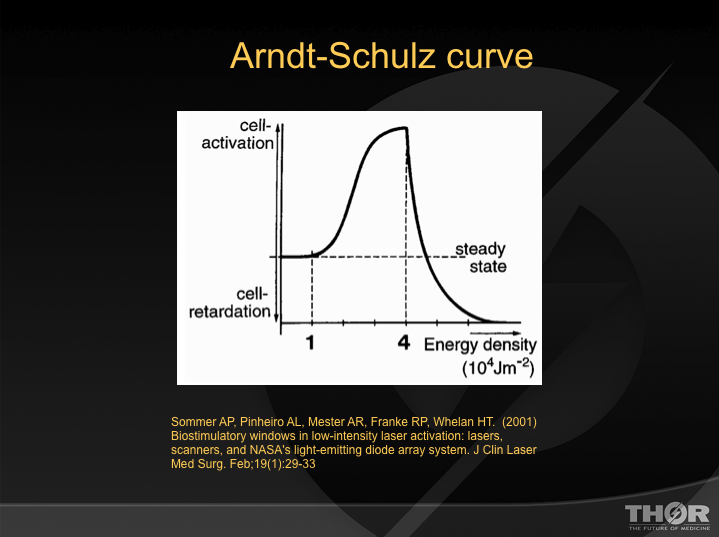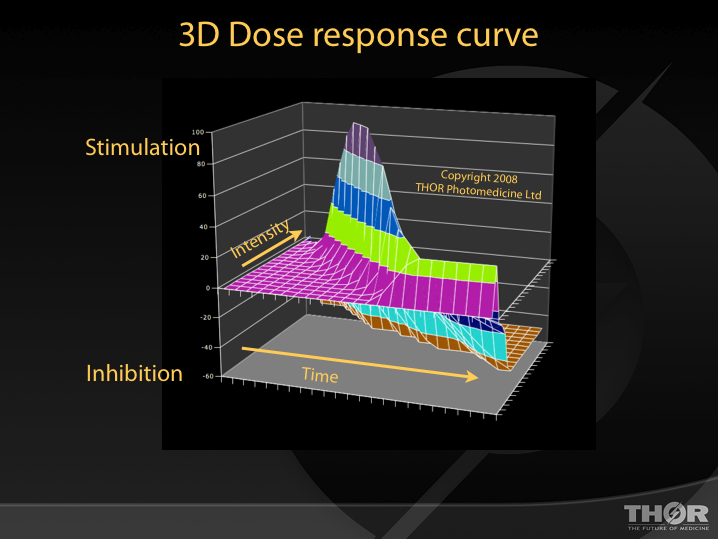This blog began as a repository for Version 3 of my 3D Photobiomodulation (PBM) dose model, but as you’ll see, it has evolved into a chronicle of my 20-year journey in PBM dosing.
This is far from the end of the discussion. I have ambitious plans for this topic—and for exposing the industry’s ongoing failure to correctly measure and report beam parameters and, consequently, dose. Expect much more in the months and years ahead.
Watch this space.
James Carroll – Fri 21 Feb 2025
Below is Version 3 of the THOR 3D PBM Hypothetical Dose Model (2025), featuring my colorised and labeled adaptation of the traditional 2D dose model. This work was created by James Carroll and is copyright © THOR Photomedicine Ltd.
These models are freely available under a Creative Commons Attribution-ShareAlike 4.0 (CC BY-SA 4.0) license, allowing you to use, share, and adapt them with proper attribution.
Need a high-resolution or vector version? Just ask.
Send an email to armourer-glimmer6k@icloud.com
Creative Commons (CC) is a licensing system that allows creators to grant others permission to use, share, and adapt their work under specified conditions while retaining some rights.
CC BY-SA 4.0 (Attribution-ShareAlike 4.0 International) is a Creative Commons license that allows anyone to copy, modify, and distribute the work, even commercially, as long as they credit the original creator and license any derivative works under the same terms.
My Version 1 of the 3D model explained below
Original text from 2008: Proc. SPIE, Vol. 6846, 684603 (2008)
http://dx.doi.org/10.1117/12.771183
A 3D dose model for low-level laser / led therapy biostimulation and bio-inhibition
Carroll JD. THOR Photomedicine Ltd, United Kingdom
Abstract
There have been numerous reports describing the phenomena of biostimulation and bioinhibition using low-level laser therapy (LLLT) and other light and IR sources within the laboratory and in clinical trials. Stimulation or inhibition employed correctly has been shown clinically to reduce pain, improve tissue repair, resolve inflammation and stimulate the immune system. All these effects are sensitive to different irradiance and / or different energy (sometimes described as dose rate or fluence rate effects). The typical ranges for biostimulation and bioinhibition will be examined and a 3D Arndt Schulz style model proposed to illustrate possible ‘dose sweet spots’ for the intended clinical effects. Keywords: Photobiomodulation, LLLT, Dose rate effects, inhibition.
INTRODUCTION The Arndt-Schultz Law is frequently quoted as a suitable model to describe dose dependant effects of LLLT. The Arndt-Schultz Law states that “weak stimuli increases physiologic activity, moderate stimuli inhibit activity, and very strong stimuli abolish activity”. Simply put; a small stimulus may have no biological effect, a moderate stimulus may have a biostimulatory effect, a large stimulus may have an bioinhibitory or even cytotoxic effect. In the context of LLLT the increasing “stimulus” may be irradiation time or it may be increased beam intensity (irradiance). A biphasic response has been demonstrated many times in LLLT research. This non-linear effect contradicts the Bunsen-Roscoe rule of reciprocity which predicts that if the products of time of exposure time and irradiance are equal, then the quantities of material undergoing change will be equal. This inverse linear relationship between intensity and time has frequently failed in LLLT research.
THE 3D MODEL
At the NAALT 2007 conference, Prof. Juanita Anders hypothesised; “If we had extended the time and irradiance ranges I believe we would have found an island in the middle of the data table indicating the effective combinations”. Karu plotted the rate of DNA synthesis dependence on light intensity and time. Taking this template for both increases in time and intensity it has been possible to speculate and redraw this in a 3 dimensional graph to illustrate how a dose “sweet spot” for biostimulation may appear when the appropriate combinations of time and irradiance are achieved at the target tissue.
Whilst this model could help explain and explore dose rate effects it must be remembered that there are many other factors affecting LLLT dosimetry including wavelength, depth of target tissue, attenuation, target cell type, state of target cells, pulse regimes and treatment intervals. Other confounding factors include a lack of beam measurement standardisation in this field of study and some unstable laser and LED product performance. These factors mean that much-published data is not robust and should be referred to cautiously. When conducting LLLT research all parameters should be recorded and published including wavelength, average power, (pulse width, pulse and peak power if any) and beam area (including the beam measurement method). The recommended method for expressing beam area is the 1/e2 point.
Chow RT, David MA, Armati PJ. (2007) 830 nm laser irradiation induces varicosity formation, reduces mitochondrial membrane potential and blocks fast axonal flow in small and medium diameter rat dorsal root ganglion neurons: implications for the analgesic effects of 830 nm laser. J Peripher Nerv Syst. Mar;12(1):28-39.
Sommer AP, Pinheiro AL, Mester AR, Franke RP, Whelan HT. (2001) Biostimulatory windows in low-intensity laser activation: lasers, scanners, and NASA’s light-emitting diode array system. J Clin Laser Med Surg. Feb;19(1):29-33
Hawkins D, Abrahamse H. (2006) Effect of multiple exposures of low-level laser therapy on the cellular responses of wounded human skin fibroblasts. Photomed Laser Surg. Dec;24(6):705-14.
Lubart R, Lavi R, Friedmann H, Rochkind S. (2006 ) Photochemistry and photobiology of light absorption by living cells. Photomed Laser Surg. Apr;24(2):179-85
Dorland’s Illustrated Medical Dictionary
Schulz, H. (1888) “Uber Hefegiste”, Pflügers Archiv Gesammte Physiologie, Vol. 42 pp.517
Zur Lehre von der Arzneiwirkung. (1887) [Virchows] Archiv für pathologische Anatomie und Physiologie und für klinische Medizin, Berlin,; 108: 423-445.
Oron U, Yaakobi T, Oron A, Hayam G, Gepstein L, Rubin O, Wolf T, Ben Haim S. (2001) Attenuation of infarct size in rats and dogs after myocardial infarction by low-energy laser irradiation. Lasers Surg Med.;28(3):204-11.
Lanzafame RJ, Stadler I, Kurtz AF, Connelly R, A T Peter Sr, Brondon P, Olson D. 2007 Reciprocity of exposure time and irradiance on energy density during photoradiation on wound healing in a murine pressure ulcer model. Lasers Surg Med. Jul;39(6):534-542.
A. Michtchenko; M. Hernandez (2006) Photobiostimulation Effects Caused for Low Level Laser Radiation with 650 nm in the Growth Stimulus of Biological Systems. Electrical and Electronics Engineering, 2006 3rd International Conference on Volume , Issue , Sept. Page(s):1 – 4
Karu TI, Kolyakov SF. (2005) Exact action spectra for cellular responses relevant to phototherapy. Photomed Laser Surg. Aug;23(4):355-61.
Juanita Anders, Tara Romanczyk, Helina Moges, Ilko Ilev, Ronald Waynant, Leonardo Longo (2007) Light Interaction With Human Central Nervous System Progenitor Cells, NAALT conference proceedings.
James Carroll (2006) The characteristics of a LLLT / Photobiomodulation light source defines the medicine. The exposure time defines the dose. A collapsed distinction. SPIE BiOS proceedings 2006.
A revised Version (2) was published in an overview paper called https://pubmed.ncbi.nlm.nih.gov/22045511/
While writing this blog, I stumbled upon an old abstract I wrote and presented in 2006 at SPIE:
The characteristics of a LLLT / Photobiomodulation. Light source defines the medicine. The exposure time defines the dose. A collapsed distinction
James Carroll AMInstP, FRSM
THOR International Ltd, United Kingdom
ABSTRACT
For nearly 40 years scientists and clinicians have expressed the “dose” of “low level laser” and other “photobiomodulation” light sources in Joules or J/Cm2 with little regard to dose-rate effects. Reporting these parameters exclusively is inadequate and misleading For example 20J might be delivered by a 100mW laser in 200 seconds with good clinical effect but 20J delivered by a 100W laser in 0.2 seconds could do considerable damage. So power and time collapsed into a single expression of dose will not necessarily predict the same effect from different power sources. Dosage has also frequently been expressed in J/cm2. This adds the parameter of area, which is another confounding factor made worse by inconsistent beam measurement methodologies. Incident beam characteristics and time must be expressed separately and dose-rate effects must be explored further.
And while I still have your attention, my first paper with Michael Hamblin remains one of my best:
Biphasic dose response in low-level light therapy.
Huang YY, Chen AC, Carroll JD, Hamblin MR
Wellman Center for Photomedicine, Massachusetts General Hospital, Boston, MA; Department of Dermatology, Harvard Medical School, Boston, MA; Aesthetic and Plastic Center of Guangxi Medical University, Nanning, P.R. China.
The use of low levels of visible or near infrared light for reducing pain, inflammation and edema, promoting healing of wounds, deeper tissues and nerves, and preventing cell death and tissue damage has been known for over forty years since the invention of lasers. Despite many reports of positive findings from experiments conducted in vitro, in animal models and in randomized controlled clinical trials, LLLT remains controversial in mainstream medicine. The biochemical mechanisms underlying the positive effects are incompletely understood, and the complexity of rationally choosing amongst a large number of illumination parameters such as wavelength, fluence, power density, pulse structure and treatment timing has led to the publication of a number of negative studies as well as many positive ones. A biphasic dose response has been frequently observed where low levels of light have a much better effect on stimulating and repairing tissues than higher levels of light. The so-called Arndt-Schulz curve is frequently used to describe this biphasic dose response. This review will cover the molecular and cellular mechanisms in LLLT, and describe some of our recent results in vitro and in vivo that provide scientific explanations for this biphasic dose response.
Dose Response 2009 7(4) 358-83
http://www.ncbi.nlm.nih.gov/pubmed/?term=20011653
 Featured Testimonials
Featured Testimonials

